If you’ve spent any time in fitness classes, personal training, or even browsing workouts online, you know that sometimes fitness lingo can sound like just a string of random, meaningless words or syllables. Like AMRAP (“as many reps/rounds as possible” in a set amount of time), or EMOM (starting a new move “every minute on the minute”), or “engage your [insert body part that you’re not quite sure how to engage here].” It’s a lot. While some people are fluent in fitness-speak, there are just as many if not more who are wondering WTF is going on.
By activating and using your core so it does all of these movements properly, you’ll be able to move more efficiently and effectively, Femi Betiku, D.P.T., C.S.C.S., Club Pilates instructor in New York, tells SELF. That also ultimately means a lower risk of injury.
One reason? It’ll help keep your lower back in a safe position. Squeezing your glutes in particular will give you a slight posterior pelvic tilt, which just means your pelvis is tucked under a tad, so that your lower back is in a neutral position, says Stokes. (If you don’t engage your core, you can revert to a more anterior pelvic tilt, where your butt’s popped out and your back is arched, which ultimately puts a lot of pressure on the lower back.)
Engaging your core also helps you cut down on over-relying on other muscles to get the power you need to crush each exercise.
“When you’re using your core along with arms or legs or both, you’re able to use the least amount of force for maximum impact,” Betiku says.
It’s a lesson Betiku recently taught one of his clients, a soccer player recovering from a hip strain. Because she was not activating her core when she kicked, her hip flexors were taking on all that work, leading to overuse. Once he taught her to fire her core, she was able to cut her reliance on her hip flexors, reduce the strain to them, and kick a soccer ball with more power.
But you don’t have to play sports to reap that benefit: The concept applies to pretty much any movement. When you’re doing a lunge, if you engage your core, you’ll take some of the work off your legs, helping you move more efficiently, do more reps, and maybe even lift heavier too. During bent-over rows, an engaged core will keep your torso from rotating in a way that tweaks your back. Same thing for deadlifts, squats—you get the picture. You’ll still primarily work the muscle you’re targeting, but your core will do the other work that needs to be done so that other muscles don’t end up overcompensating.
What does it really mean to “activate” your core?
Before you can learn how to activate your core, you first need to understand what your core actually is. Spoiler: It’s way more than just your abdominal muscles.
Original Article by Amy Marturana Winderl, C.P.T.
| See Full Article Here |


